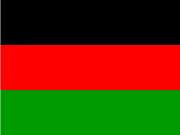Tehrik-e-Jafaria
Tehrik-e-Jafaria Pakistan (TJP) تحریکِ جعفریہ | |
|---|---|
 | |
| Patron-in-chief | Syed Sajid Ali Naqvi |
| Founder | Arif Hussain Hussaini |
| Founded | 1979 |
| Political wing | Shia Ulema Council |
| Religion | Shia Islam |
| Colors | Black, Red |
| Gilgit-Baltistan Assembly | 3 / 33 |
History
After the death of Mufti Jafar Hussain TNFH split into two groups named TNFJ-Agha Syed Hamid Ali Shah Moosavi group and TNFJ-Arif Hussaini group respectively due to ideological differences between the two leaders. Arif Hussain Hussaini, a student of Ruhollah Khomeini who led the Iranian Revolution, was the group's leader.[1]
Its creation coincided with the Shia revolution in Iran and enforcement of controversial Islamic laws by the military ruler of Pakistan, General Zia-ul-Haq. The revolution in predominantly Shia Iran around the same time gave an added boost to the organisation. Its leader, Arif Hussain Hussaini was a student of the leader of Iran's Islamic Revolution, Ruhollah Khomeini.[1]
— BBC News
Later in 1988, Arif Hussain Hussaini changed the name of his group from TNFJ-Arif Hussaini group to Tehrik-e-Jafaria (TJP) while Agha Syed Hamid Ali Shah Moosavi's group retained the name of TNFJ and has been operating under the same name since. The TJP founder, Arif Hussain Hussaini was assassinated in 1988 by unknown attackers; the defunct sectarian group Sipah-e-Sahaba was accused.
Arif Hussain Hussaini, the patron-in-chief of the TJP, was shot dead in Peshawar near his mosque/seminary while going to lead the morning prayer on August 5, 1988. Since then, T.J.P. has been led by Hussaini's one of the foremost companions Syed Sajid Ali Naqvi.
Following the death of Zia-ul-Haq, support for the TJP fell, as Pakistani Shias went back to pre-Zia-ul-Haq political loyalties, with many no longer feeling under threat. Furthermore, the elections of moderate Benazir Bhutto also gave increased confidence to Shia Muslims and they were no longer under threat and the discrimination ended even though it still exist against the Pakistani Shias.
Jafaria Students Organization Pakistan, founded in 1997, is the student wing of TJP.
Ideology
According to TJP, Islam is and was the basic ideology of Pakistan; by deviating this ideology a conspiracy was made to make Pakistan a sectarian state in the period of General Zia-ul-Haq, a dictator. At this stage, the formation of TNFJ was deemed necessary for the failure of this conspiracy.
The main objective of this organisation was to protect the rights of Shia Muslims of Pakistan and give them a voice in the Parliament of Pakistan. They do not advocate a Shia Islamic state and have cordial relations with Sunni organization including Sunni Ittehad Council, that is why they joined the coalition of religious political parties Muttahida Majlis-e-Amal that won 53 out of 272 elected members in legislative elections held on October 20, 2002.
Sanctions
On January 12, 2002, the TJP was banned along with three terrorist organizations, by the government of Pakistan.[2]
The TJP was banned twice by Pervez Musharraf's government and in January 2002, its leaders were arrested. The T.J.P. was banned again on November 5, 2011, while Pakistan's Shias experienced increasing attacks since 2005 by the Pakistani Taliban, Sipah-e-Sahaba, Lashkar-e-Jhangvi, Jundullah and Jaish-e-Mohammed,[3]
Although TJP has been designated as a "terrorist organisation", Qazi Hussain Ahmad, a senior member of Pakistani Parliament and the leader of Jamaat-e-Islami, Pakistan's oldest Islamist party, says the banned groups have no ties with the militants. He notes that one organization is part of the Muttahida Majlis-e-Amal, the major opposition alliance of religious parties, which also includes Ahmad's group.
As far as T.J.P. is concerned, it is a part of Muttahida Majlis-e-Amal, and it is a political organization, it is not a militant organization. [Qazi Hussain Ahmad]
Coalition
It was a part of the Muttahida Majlis-e-Amal coalition of Islamist political parties that won 11.3% of the popular vote and 53 out of 272 seats in the legislative elections held on October 20, 2002. In May 2008, it was reported that Jamaat-e-Islami Pakistan's emir Qazi Hussain Ahmad was considered heading the six-party Muttahida Majlis-e-Amal. Qazi Hussain Ahmad said that he would consider rejoining the MMA after consulting with the executive council of his party and some other seniors. Jamiat Ulema-e-Islam (F)'s chief Fazl-ur-Rahman had tasked Sajid Naqvi of TJP with contacting Qazi Hussain Ahmad and bringing him round to rejoining the alliance.
Tehrik-e-Jafaria Pakistan, also known as Tehrik-e-Islami, should not be confused with a short-lived outfit named Tehrik-e-Islami that was one of three groups of Pakistani Taliban operating during 2008 in Darra Adam Khel, a semi-tribal area known officially as the Frontier Region of Kohat. The Tehrik-e-Islami and the Pakistan Taliban became active in the area in mid-2007. The former Tehrik-e-Islami was founded by a local Afridi tribesman named Muneer Khan, while the Islamic Taliban was founded by Momin Afridi. The groups later merged and became part of the Tehrik-i-Taliban Pakistan. Both leaders were killed in a military operation in the area in 2008.[4]
See also
- Jafaria Students Organization Pakistan
- Majlis Wahdat-e-Muslimeen
- Shia Ulema Council
- Imamia Students Organization
- Sipah-e-Muhammad Pakistan
References
- "Pakistan's militant Islamic groups". BBC News. 13 January 2002.
- "Pakistan: International Religious Freedom Report 2002". Bureau of Democracy, Human Rights, and Labor. United States Department of State. January 13, 2002.
- "Suicide bomber kills 24 at Shia mosque in Pakistan". Long War Journal. 5 April 2009.
- "Tehrik-e-Islami / Tehrik-e-Jafaria Pakistan (TJP)". GlobalSecurity.org.